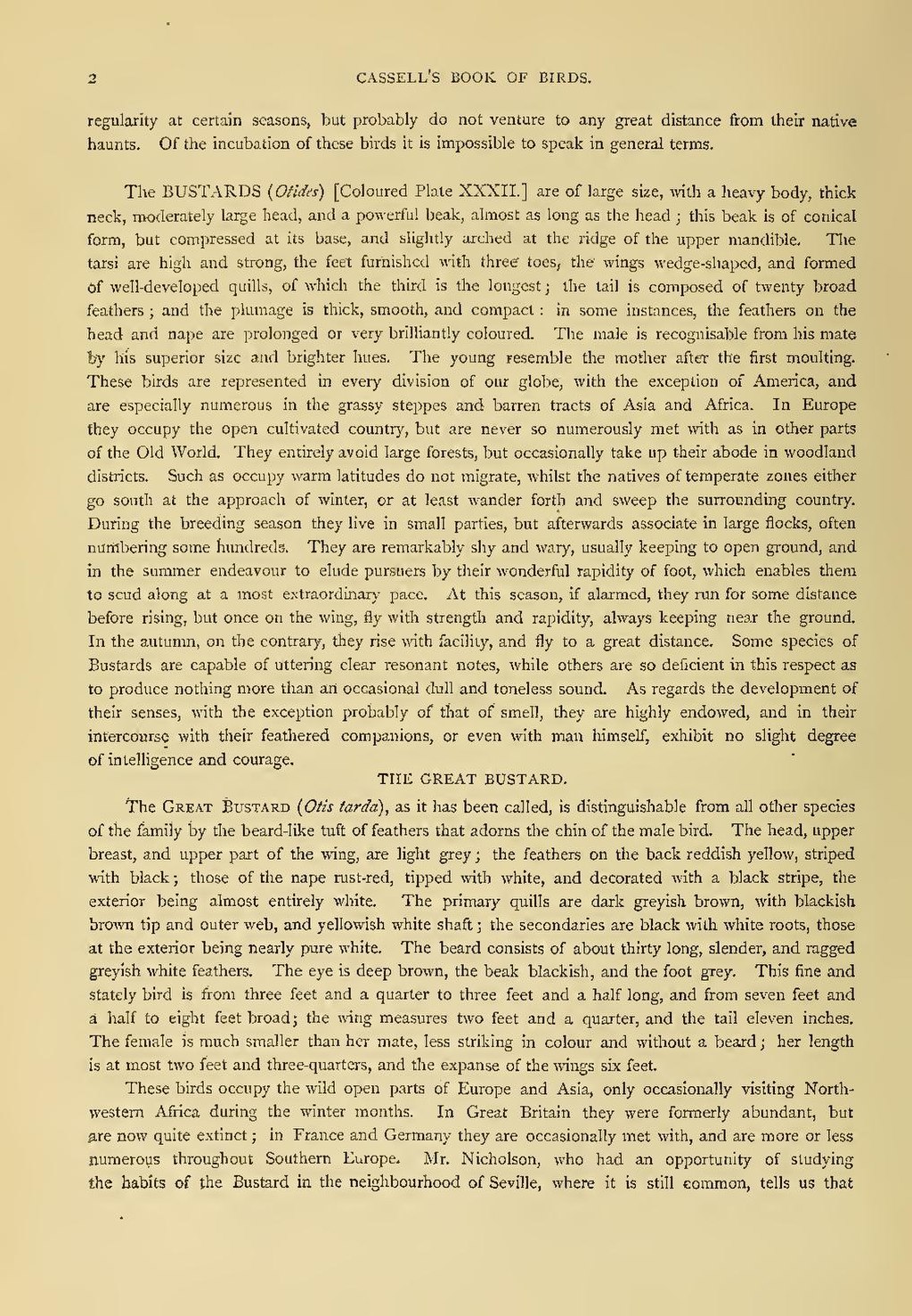regularity at certain seasons, but probably do not venture to any great distance from their native haunts. Of the incubation of these birds it is impossible to speak in general terms.
The BUSTARDS (Otides) [Coloured Plate XXXII.] are of large size, with a heavy body, thick neck, moderately large head, and a powerful beak, almost as long as the head; this beak is of conical form, but compressed at its base, and slightly arched at the ridge of the upper mandible. The tarsi are high and strong, the feet furnished with three toes, the wings wedge-shaped, and formed of well-developed quills, of which the third is the longest; the tail is composed of twenty broad feathers; and the plumage is thick, smooth, and compact: in some instances, the feathers on the head and nape are prolonged or very brilliantly coloured. The male is recognisable from his mate by his superior size and brighter hues. The young resemble the mother after the first moulting. These birds are represented in every division of our globe, with the exception of America, and are especially numerous in the grassy steppes and barren tracts of Asia and Africa. In Europe they occupy the open cultivated country, but are never so numerously met with as in other parts of the Old World. They entirely avoid large forests, but occasionally take up their abode in woodland districts. Such as occupy warm latitudes do not migrate, whilst the natives of temperate zones either go south at the approach of winter, or at least wander forth and sweep the surrounding country. During the breeding season they live in small parties, but afterwards associate in large flocks, often numbering some hundreds. They are remarkably shy and wary, usually keeping to open ground, and in the summer endeavour to elude pursuers by their wonderful rapidity of foot, which enables them to scud along at a most extraordinary pace. At this season, if alarmed, they run for some distance before rising, but once on the wing, fly with strength and rapidity, always keeping near the ground. In the autumn, on the contrary, they rise with facility, and fly to a great distance. Some species of Bustards are capable of uttering clear resonant notes, while others are so deficient in this respect as to produce nothing more than an occasional dull and toneless sound. As regards the development of their senses, with the exception probably of that of smell, they are highly endowed, and in their intercourse with their feathered companions, or even with man himself, exhibit no slight degree of intelligence and courage.
THE GREAT BUSTARD.
The Great Bustard (Otis tarda), as it has been called, is distinguishable from all other species of the family by the beard-like tuft of feathers that adorns the chin of the male bird. The head, upper breast, and upper part of the wing, are light grey; the feathers on the back reddish yellow, striped with black; those of the nape rust-red, tipped with white, and decorated with a black stripe, the exterior being almost entirely white. The primary quills are dark greyish brown, with blackish brown tip and outer web, and yellowish white shaft; the secondaries are black with white roots, those at the exterior being nearly pure white. The beard consists of about thirty long, slender, and ragged greyish white feathers. The eye is deep brown, the beak blackish, and the foot grey. This fine and stately bird is from three feet and a quarter to three feet and a half long, and from seven feet and a half to eight feet broad; the wing measures two feet and a quarter, and the tail eleven inches. The female is much smaller than her mate, less striking in colour and without a beard; her length is at most two feet and three-quarters, and the expanse of the wings six feet.
These birds occupy the wild open parts of Europe and Asia, only occasionally visiting North-western Africa during the winter months. In Great Britain they were formerly abundant, but are now quite extinct; in France and Germany they are occasionally met with, and are more or less numerous throughout Southern Europe. Mr. Nicholson, who had an opportunity of studying the habits of the Bustard in the neighbourhood of Seville, where it is still common, tells us that
